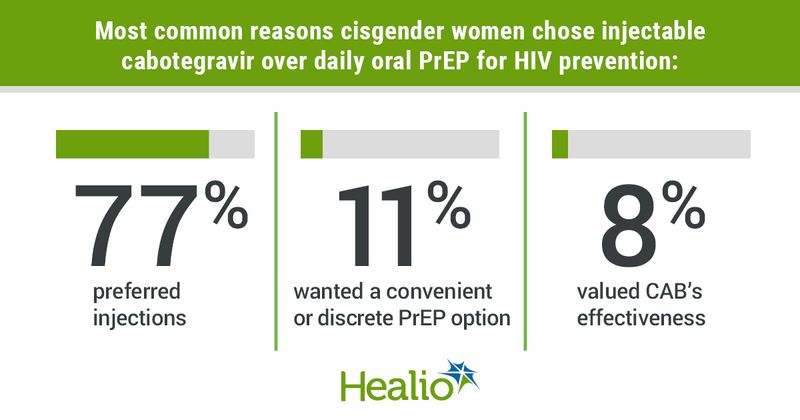Infection
Women in study preferred long-acting injectable HIV PrEP over daily pill
July 22, 2023
2 min read
Source/Disclosures
Published by:
Delany-Moretlwe S, et al. Abstract 5998. Presented at: International AIDS Society Conference on HIV Science; July 23-26, 2023; Brisbane, Australia.
Disclosures:
Hosseinipour reports no relevant financial disclosures.
Key takeaways:
- Among nearly 2,500 women, almost 80% chose long-acting, injectable cabotegravir for HIV PrEP.
- Reasons included preferring injections, wanting a discrete PrEP method and known effectiveness.
Cisgender women preferred long-acting injectable PrEP over taking a daily pill for HIV prevention by a nearly 4-to-1 margin, according to study findings presented at the International AIDS Society conference.
“The HPTN 084 study showed that injectable cabotegravir (CAB) was superior to daily oral tenofovir disoproxil fumarate/emtricitabine (TDF/FTC) among cisgender women, and actually men as well, though our studies focused on women,” Mina Hosseinipour, MD, MPH, professor of medicine at the University of North Carolina Chapel Hill, said during a press conference. “So, in 2022, we offered an open-label extension, where participants were able to make a choice of which product they would like to use.”
Hosseinipour and colleagues offered 2,472 women who participated in HPTN 084 the option to continue receiving their study drug or switch to CAB or daily oral TDF/FTC.
Ultimately, 78% chose CAB and the remaining 22% chose TDF/FTC.
Among patients initially randomly assigned to receive TDF/FTC in HPTN 084 (n = 1,219), 67% chose CAB — with 15% opting for the oral lead-in and 53% preferring to begin CAB right away. Only 11% of patients initially randomly assigned to CAB chose to switch to TDF/FTC.
The study revealed that among participants who chose CAB, 77% cited preferring injections as the reason, whereas 11% desired a convenient or discrete PrEP method, and 8% valued CAB effectiveness, the researchers reported. Among those who chose TDF/FTC, 81% preferred pills, 5% were worried about injection pain or side effects and 1% desired pregnancy.
According to the researchers, study participants who chose CAB were more likely to be sexually active but not live with their partner (P < .025), to have experienced recent physical intimate partner violence (P < .013) and to have been paid for sex (P < .002).
Additionally, overall decision conflict scores were low and similar between both groups (CAB = 14 vs. TDF/FTC = 16; P = .9), effective decision subscore differences suggest CAB users perceived more strongly that they had made a good decision (CAB = 6 vs. TDF/FTC = 13; P = .011).
“Participants were very competent in their decision-making in terms of the decision or conflict score, and this gives us confidence that they may be able to be retained on PrEP more easily,” Hosseinipour said. “I think that this gives us insight into what countries should expect from women as they begin programs with CAB, and we really need to cater for the choice that women want to make in their prevention products.”


